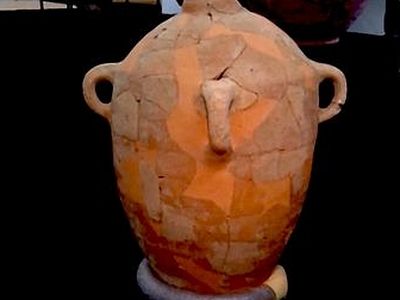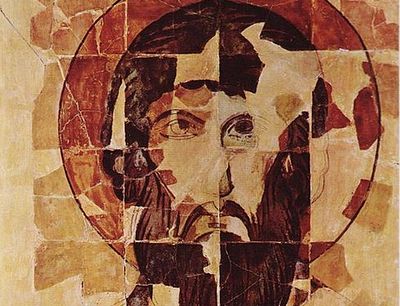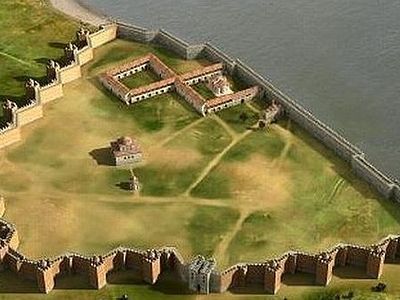Source: Archaeology in Bulgaria
October 23, 2015
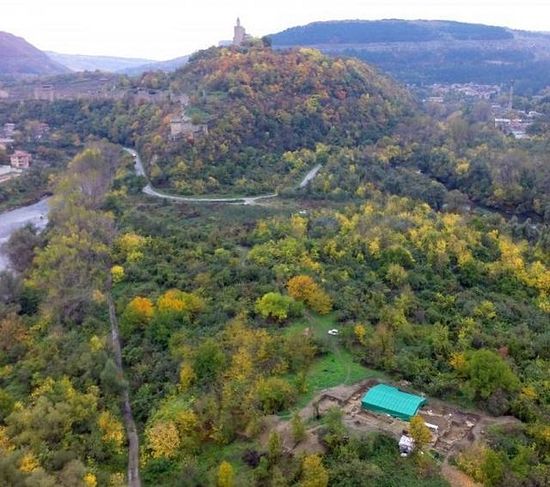 A view of the excavation site of the Early Byzantine basilica and the 13th century Bulgarian monastery (in the front), with the Tsarevets Hill Fortress in the background. According to the latest hypothesis, before becoming part of the capital of the Second Bulgarian Empire in the 12th-14th century, the Tsarevets Hill was the site of a major Byzantine city. Photo: BTA/Archaeological Team
A view of the excavation site of the Early Byzantine basilica and the 13th century Bulgarian monastery (in the front), with the Tsarevets Hill Fortress in the background. According to the latest hypothesis, before becoming part of the capital of the Second Bulgarian Empire in the 12th-14th century, the Tsarevets Hill was the site of a major Byzantine city. Photo: BTA/Archaeological Team
The Early Byzantine basilica which was discovered recently in the city of Veliko Tarnovo in Northern Bulgaria may prove the key to the exploration of what was an unknown but major Byzantine city, and to answering the question why Veliko Tarnovo, then known as Tarnovgrad, was made the capital of the Second Bulgarian Empire (1185-1396 AD).
This hypothesis has been presented by Prof. Hitko Vachev from the Veliko Tarnovo Regional Museum of History who discovered the Early Byzantine basilica southeast of the fortress wall of the Tsarevets Hill Fortress, in the so called Frenkhisar, or the “Frankish Quarter”, of the medieval Tarnovgrad.
Speaking at a news conference in Sofia, Vachev has pointed out that the 6th century Byzantine basilica that he found was impressive in size meaning that most probably it was the seat of a bishop, a completely unknown fact until now, reports BTA.
In a nutshell, the archaeologist’s hypothesis is that the presence of a bishopric in the Early Byzantine period in what later became the medieval Bulgarian city of Tarnovgrad (Veliko Tarnovo), with its two citadels, the Tsarevets Hill Fortress and the Trapesitsa Hill Fortress, means that in the Late Antiquityand Early Middle Ages, the Tsarevets Hill was the site of “one of the most fortified Byzantine cities”.
The existence of such an Early Byzantine city on Tsarevets would explain why Tarnovgrad was picked as the capital of the Second Bulgarian Empire enabling it to emerge as a power center rivaling Constantinople for much of the High and Late Middle Ages, the reasoning goes.
While the period of the Second Bulgarian Empire, the 12th-14th century AD, has been more thoroughlyresearched in the archaeological sites in Veliko Tarnovo, this has not been the case with the period ofthe Late Antiquity and the Early Middle Ages.
This is the reason Bulgaria’s archaeologists keep making notable discoveries there such as Vachev’s 2014 discovery of an unknown monastery, and the recent discoveries in the Trapesitsa Hill Fortress,and in the nearby fortress Rahovets where Tarnovgrad’s garrison was stationed in the 13th-14thcentury AD.
The Early Byzantine basilica, which has given Vachev grounds for his new hypothesis that beforeTarnovgrad became the capital of the Second Bulgarian Empire it was the site of a bishopric and amajor heavily fortified Byzantine city, has been found during the continuing excavations of the ruins of the Bulgarian monastery from the 13th century that the archaeologist found in 2014.
Upon excavating further the ruins of the Early Byzantine temple, the archaeologist and his team have found that it was 40 meters long and 20 meters wide. The imposing size, among its other features, indicates the importance of the church and the possibility that it may have been the seat of a bishop.
It was on top of these Early Byzantine ruins that the church of what was the Monastery of the Mother of God (Virgin Mary) was built in the 13th century AD by the Bulgarians.
“If the hypothesis [that the basilica was a bishop’s temple] is proven, and the further excavations show that one of the most fortified Byzantine cities was built on top of Tsarevets as a the center of abishopric, this will provide clarity as to why of all cities [Veliko] Tarnovo was chosen to be the capital of the Second Bulgarian Empire,” Vachev explains.
The choice of Tarnovgrad as the Bulgarian capital after Bulgaria was liberated from Byzantium in 1185 AD has been thought to have to do with the fact that the first Tsars of the Second Bulgarian Empire,the boyars Asen and Teodor (Petar), were natives of the region located in today’s Central Northern Bulgaria.
The capitals of the First Bulgarian Empire (632/680 – 1018 AD) had been Pliska (680-893 AD) and Veliki Preslav (893-970 AD) in today’s Northeast Bulgaria, and Ohrid (from the end of the 10th century until 1018 AD) in today’s Republic of Macedonia.
“Last year, when we started the excavations we knew that Tarnovgrad had three monasteries dedicated to the Holy Mother of God. We didn’t know where they were located. The Virgin Mary was the patron of the city, and the cult for her was very strong there. We have found the church of thismonastery complex, and we have enough data to suggest that this probably is the Dormition of the Mother of God Monastery mentioned by Grigoriy (Gregory) Tsamblak (ca. 1365-1420, Bulgarian cleric and metropolitan of Kiev – editor’s note),” explains the archaeologist.
He reminds that upon the discovery of the monastery in 2014 his team also found graves of medieval Bulgarian aristocrats and clerics, and a brick tomb of a noble woman.
Under the head of one of the buried men, the archaeologists found a brick with engraved verses 1-4 from the Gospel of John, which is the first time such a discovery has been made in Bulgaria.
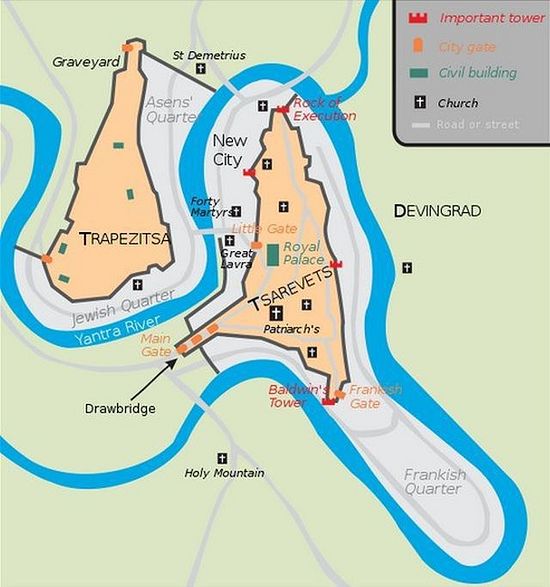 A map of Tarnovgrad, capital of the Second Bulgarian Empire (1185-1396 AD), today’s Veliko Tarnovo, showing the location of Frenkhisar (the Frankish Quarter) in the southeast. Map: Martyr, Wikipedia
A map of Tarnovgrad, capital of the Second Bulgarian Empire (1185-1396 AD), today’s Veliko Tarnovo, showing the location of Frenkhisar (the Frankish Quarter) in the southeast. Map: Martyr, Wikipedia
The 2015 excavations were started by Vachev’s team with the goal of studying further the necropolisand the buildings of the 13th century monastery they found in 2014.
“[However,] we came across artifacts suggesting that we may unearth [structures from] earlier periods. To my great satisfaction, we have revealed partly this Early Byzantine basilica. Its size is 40 meters by 20 meters, and there is no doubt that this was an extremely important building changing our perceptions about Veliko Tarnovo and the inheriting of the religious sites,” Vachev states.
He elaborates that in the Early Byzantine period the Tsarevets Hill towering above the site where the basilica is situated apparently grew into one of the largest fortified cities in provinces of Byzantium, i.e. the Eastern Roman Empire, a successor of the glorious Ancient Roman city of Nicopolis ad Istrum whose ruins are located to the north of Veliko Tarnovo.
“In the 5th-7th century, a settlement emerged on the Tsarevets Hill which grew into a fortified city, asuccessor of the Roman and Early Byzantine city Nicopolis ad Istrum which was also a bishopric center. We know the names of two bishops of Nicopolis ad Istrum. After a number of [barbarian] invasions, and the waning of Nicopolis ad Istrum, the bishopric moved to Tsarevets, and this is where one of the largest cities in the northern provinces of Byzantium developed,” Vachev says.
“The discovery of this basilica raises some issues, and allows us to resolve some questions with respect to the development of the city which beyond doubt had a huge area. The fact that in Early Byzantine Era Veliko Tarnovo developed on such an impressive territory, I think, gives us an answer as to why at the end of the 12th century precisely this city was picked as the capital of the restored Bulgarian state,”explains the archaeologist.
In addition to the new hypothesis about the life in Tarnovgrad in the Early Byzantine period and the choice of the capital of the Second Bulgarian Empire, the latest excavations by Vachev’s team in theFrenkhisar quarter of the medieval city provided evidence that the site was inhabited from the 6th until the 18th century AD.
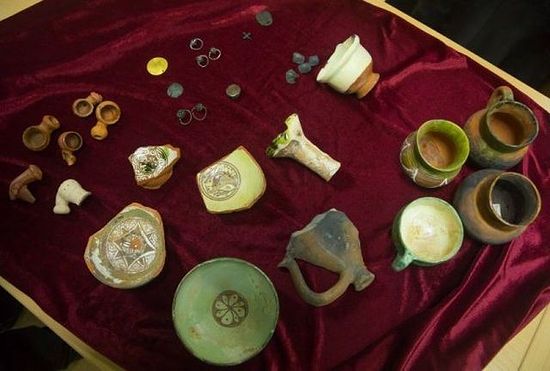 Artifacts from different time periods such as ceramic vessels and gold Ottoman coin have been discovered during the digs in the Frankish Quarter of Tarnovgrad. Photo: BTA
Artifacts from different time periods such as ceramic vessels and gold Ottoman coin have been discovered during the digs in the Frankish Quarter of Tarnovgrad. Photo: BTA
The archaeologists have unearthed a number of archaeological artifacts including jewelry decorations, ceramic vessels, and a gold coin of Ottoman Turkish Sultan Abdul Hamid I (r. 1774-1789)
“The artifacts, which have already been restored by Mihaela Romanova and Iliyan Petrakiev, date from the 6th until the 18th century, and trace the life of the settlement in this part of the city,” Vachev says.
The archaeologist hopes that his discovery will provide reasons for a much wider research effort into the respective part of the medieval city of Tarnovgrad.
He and his team are convinced that the site the working on is a holy place which is why they set up there a small chapel in the name of the Mother of God funding it on their own.
“In any case, this is a very holy place, and 7 centuries after the creation of the monastery this holiness needs to be underscored. This is also the way to promote a site that is yet to be developed,” Vachev concludes.
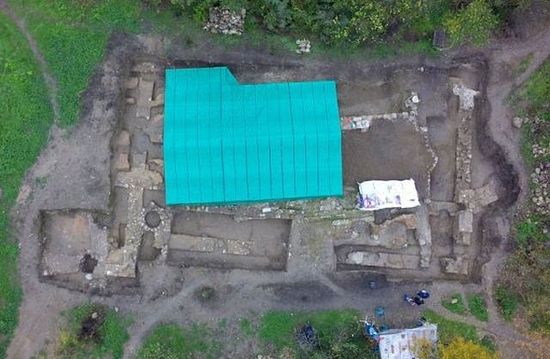 An aerial view of the excavation site of the 13th century Bulgarian monastery and the 6th century Byzantine basilica in the Frenkhisar (Frankish Quarter) of Tarnovgrad, Bulgaria’s Veliko Tarnovo. Photo: BTA/Archaeological Team
An aerial view of the excavation site of the 13th century Bulgarian monastery and the 6th century Byzantine basilica in the Frenkhisar (Frankish Quarter) of Tarnovgrad, Bulgaria’s Veliko Tarnovo. Photo: BTA/Archaeological Team
In August 2015, the team of Hitko Vachev found the dining room of the monastery in question.
The medieval Mother of God Monastery in Veliko Tarnovo was one of the major archaeological discoveries in Bulgaria in 2014. Its ruins are located to the southeast of the fortress wall of the Tsarevets Hill Fortress, in the so called Frenkhisar, or “Frankish Quarter”, of the capital of the Second Bulgarian Empire Tarnovgrad.
The Frankish Quarter is overlooked by the so called Baldwin’s Tower. It is named after Latin EmperorBaldwin I of Constantinople (Baldwin of Flanders), ruler of the Latin Empire of the Crusaders from the Third Crusade, who was kept and died there in captivity, after was taken prisoner by the Bulgarian Tsar Kaloyan (r. 1197-1207 AD) in the Battle of Adrianople.
While it had long been believed that the Frankish Quarter’s name stemmed from the fact that during the High and Late Middle Ages it was populated by Western European merchants trading in the Bulgarian capital Tarnovgrad, in 2010 Veliko Tarnovo archaeologist Evgeni Dermendzhiev carried outexcavations there and found no evidence of Western European presence.
Instead, he discovered that in the High and Late Middle Ages the quarter was inhabited by Bulgarian craftsmen who specialized in metallurgy and especially in iron production.
Background Infonotes:
The Tsarevets Hill is one of two main fortified historic hills in the medieval city of Tarnovgrad,today’s Veliko Tarnovo, in Central Northern Bulgaria, the capital of the Second Bulgarian Empirebetween 1185 and 1396 AD. Together with the Trapesitsa Hill, Tsarevets was one of the two fortressesof the inner city acropolis of Tarnovgrad (Veliko Tarnovo). The Tsarevets Hill is a natural fortress on the left bank of the Yantra River, and is surrounded by it on all four sides with the exception of a small section to the southwest. It is located southeast of the Trapesitsa Hill. The Tsarevets Fortress had threegates, the main one being its southwestern gate. The name of Tsarevets stems from the word “tsar”, i.e. emperor.
The first settlement on the Tsarevets Hill in Bulgaria’s Veliko Tarnovo dates to the Late Chalcolithic (Aeneolithic, Copper Age), around 4,200 BC. The hill was also inhabited during the Bronze Age and Iron Age by the Ancient Thracians, and there have been hypothesis that it was the site of thelegendary Ancient Thracian city Zikideva – even though a recent hypothesis claims that Zikideva was in fact located in the nearby fortress Rahovets. An Ancient Bulgar settlement was built on theTsarevets Hill in the 9th century AD, during the First Bulgarian Empire (632/680-1018 AD) which later grew into a city. The Tsarevets Hill rose to prominence as the center of the Second Bulgarian Empire(1185-1396 AD) in 1187, after the successful Uprising of Asen and Petar, later Tsar Asen I (r. 1190-1195 AD) and Tsar Petar IV (r. 1185-1197), who ruled as co-emperors, against the Byzantine Empire in 1185-1186 AD.
Thus, the construction of the Tsarevets Hill Fortress began in the 12th century AD. The total length of the Tsarevets Hill fortress wall is 1,1 km, and it reaches a height of 10 meters (on top of the natural defenses of the hill’s slopes) and a width of 2.4-3.6 meters. The most vulnerable point of the Tsarevets fortification was the southeast section with its gate; however, it was protected by the so called Baldwin’s Tower because it is known that after defeating the Crusader knights from the 3rd Crusade in the Battle of Adrianople in 1205 AD, the Bulgarian Tsar Kaloyan captured the Latin Emperor of Constantinople Baldwin of Flanders, and kept him captive in the tower for several months, until Baldwin’s death. The Baldwin’s Tower was restored in 1933 by Bulgarian archaeologist and architect Alexander Rashenov; the restored Baldwin’s Tower was modeled after the surviving fortress tower in another medieval Bulgarian city, the Cherven Fortress.
The medieval church of the Bulgarian Patriarchate is located in the center of the Tsarevets Hill. It is called the Church of the Ascension of God, and was restored in 1981. The church was known as the“mother of all Bulgarian churches”, and was part of a complex with a territory of 2,400 square meters. Right next to it are the ruins of the imperial palace of the monarchs from the Second Bulgarian Empire which had a territory of almost 3,000 square meters. Both the imperial palace and the Patriarchate’s complex were surrounded by fortress walls and protected by towers. The archaeological excavations on the Tsarevets Hill have revealed the foundations of a total of 470 residences which housed the high-ranking Bulgarian aristocracy, 23 churches and 4 urban monasteries as well as a medieval inn. In the northern-most point of the Tsarevets Hill there is a high cliff cape known as the Cliff of Executions which in the 12th-14th century AD was used for executing traitors by throwing them into the canyon of the Yantra River.
For some 200 years the medieval Tarnovgrad, also known as Tsarevgrad Tarnov (i.e. the Tsar’s City), together with its fortresses Tsarevets, Trapesitsa, and Momina Krepost (“Maiden’s Fortress”), also known as Devingrad (“Virgins’ Town”), rivaled Constantinople as the most important city in this part of Europe, with some of the most glorious and famous Bulgarian Tsars – Tsar Asen (r. 1190-1195), Tsar Petar (r. 1185-1197), Tsar Kaloyan (r. 1197-1207), Tsar Ivan Asen II (r. 1218-1241), Tsar Konstantin Asen Tih (r. 1257-1277), Tsar Ivaylo (r. 1277-1280), Tsar Todor (Theodore) Svetoslav (r. 1300-1322), Tsar Ivan Alexander (r. 1331-1371), and Tsar Ivan Shishman (r. 1371-1395) – ruling their empire from Tsarevets.
Tsarevets and the rest of Tarnovgrad had a tragic fate, however, after in 1393 AD, after a three-month siege, it became the first European capital to fall prey to the invading Ottoman Turks. This was somewhat of a logical outcome after the de facto feudal disintegration of the Second Bulgarian Empire in the second half of the 14th century. After Bulgarian Tsar Ivan Alexander (r. 1331-1371 AD)lost his two eldest sons – Ivan in 1349 AD and Mihail in 1355 AD – in battles with the Ottoman Turks, he failed to prevent a number of Bulgarian feudal lords from seceding, and on top of that divided the remainder of the Bulgarian Tsardom between his two surviving sons. His third son Ivan Sratsimir (r. 1371-1396) received the smaller so called Vidin Tsardom, with the Danube city of Bdin (Vidin) as its capital, and his fourth son Ivan Shishman (r. 1371-1395) received the rest, the so called Tarnovo Tsardom, with the capital proper of Tarnovgrad (today’s Veliko Tarnovo). Just two decades later all Bulgarian lands, disunited and even warring among themselves, fell prey to the invading Ottoman Turks, ushering Bulgaria into five centuries of Ottoman Yoke (1396-1878/1912), and signifying a practically irreversible loss of its former great power status.
As the last ruler of Tarnovgrad, Tsar Ivan Shishman was not in the capital at the time it was besieged by the forces of Ottoman Sultan Bayezid I (r. 1389-1402 AD), its defense was led by the legendary Bulgarian Patriarch St. Euthymius (Evtimiy) of Tarnovo (ca. 1325-ca. 1402-1404 AD), the founder of the Tarnovo Literary School. After they conquered the Bulgarian capital on July 17, 1393, the Ottoman Turks slaughtered its population – an especially dramatic scene was the beheading of 110 capturedBulgarian aristocrats, and razed to the ground the Bulgarian imperial palace and the churches and monasteries of the Bulgarian Patriarchate. Tsarevets and Veliko Tarnovo were liberated from the Turks in the summer of 1877 in the Russian-Turkish War of 1877-1878 that restored the Bulgarian state.
The archaeological restoration of the Tsarevets Hill Fortress began in 1930 and was completed in 1981, the year that was celebrated, now somewhat questionably, as the 1300th anniversary since thefounding of the Bulgarian state. Tourists visiting Tsarevets can view the so called “Sound and Light” audiovisual show, an attraction using lasers and music to tell the story of the medieval Bulgarian Empire as well as Bulgaria’s fight for freedom against the Ottoman Empire, and the story ofBulgaria’s National Liberation. It was first launched in 1985 for the 800th anniversary since theUprising of Asen and Petar. The Tsarevets Fortress was granted a protected status by the Bulgarian government for the first time in 1927, and in 1964 it was declared a “monument of culture of national importance”.
The Trapesitsa Hill is one of two main fortified historic hills in the medieval city of Tarnovgrad,today’s Veliko Tarnovo, in Central Northern Bulgaria, the capital of the Second Bulgarian Empire between 1185 and 1396 AD. Together with the Tsarevets Hill, Trapesitsa was one of the two fortresses of the inner city acropolis of Tarnovgrad (Veliko Tarnovo). The Trapesitsa Hill is a natural fortress on the right bank of the Yantra River, and is surrounded by it on three sides. It is located northwest of the Tsarevets Hill. The Trapesitsa Fortress had four gates, the main one being its southern gate, which was also connected with the Tsarevets Fortress with a bridge across the Yantra River. There are two hypotheses about Trapesitsa’s name. The first one is that it comes from the Bulgarian word “trapeza” meaning a “table” or “repast”, possibly referring to the receptions of the medieval Bulgarian Tsars; the second hypothesis is that the word comes from “trapezium” because the hill is in fact is a trapezoidal plateau.
The first archaeological excavations on the Trapesitsa Hill Fortress in Bulgaria’s Veliko Tarnovobetween 1884 and 1900 revealed the foundations of 17 medieval Bulgarian churches with fragments of rich murals, colorful mosaics, and beautiful floor tiles. The documented artifacts discovered there include crosses, necklaces, coins, rings, earrings, vessels. The churches on Trapesitsa were richly decorated with various architectural forms such as pilasters, niches, blind arches, colored slabs,among others.
The largest preserved church on the Trapesitsa Hill known as “Church No. 8” is named after the 10thcentury AD Bulgarian saint, St. Ivan Rilski (St. John of Rila) (876-946 AD); it was surrounded with other buildings which are believed to have been part of a monastery complex. It is known that in 1195 AD, Bulgaria’s Tsar Asen I (r. 1189-1196 AD) transported the relics of St. Ivan Rilski from the city of Sredets(today’s Sofia) to Tarnovgrad (today’s Veliko Tarnovo), and had them placed in the specially constructed church on the Trapesitsa Hill. The Bulgarian archaeologists believe that a room in the southern part of Church No. 8 was the reliquary for St. Ivan Rilski’s relics.
The relics of St. Ivan Rilski (St. John of Rila), who is Bulgaria’s patron saint, were kept in Veliko Tarnovo until 1469 AD when they were transported to the Rila Monastery where they are kept to this day in what became a major event for the Bulgarians during the early period of the Ottoman Yoke (1396-1878/1912), as the Second Bulgarian Empire had been conquered by the invading Ottoman Turks in 1396 AD. The numerous and richly decorated small churches indicate that the Trapesitsa Hillharbored the homes of the medieval Bulgarian nobility, the boyars, and the supreme clergy. More recent excavations, however, also indicate that the imperial palace of the early Bulgarian Tsars from the House of Asen (the Asen Dynasty, r. 1185-1257 AD) was in fact located on the Trapesitsa Hill, and the imperial seat was possibly moved to the nearby Tsarevets Hill only later, during the reign of Tsar Ivan Asen II (r. 1218-1241 AD). In the recent years, the Trapesitsa Hill has been excavated by Prof. Konstantin Totev from the Veliko Tarnovo Branch of the National Institute and Museum of Archaeology of the Bulgarian Academy of Sciences, and by Prof. Hitko Vatchev from the Veliko Tarnovo Regional Museum of History.
